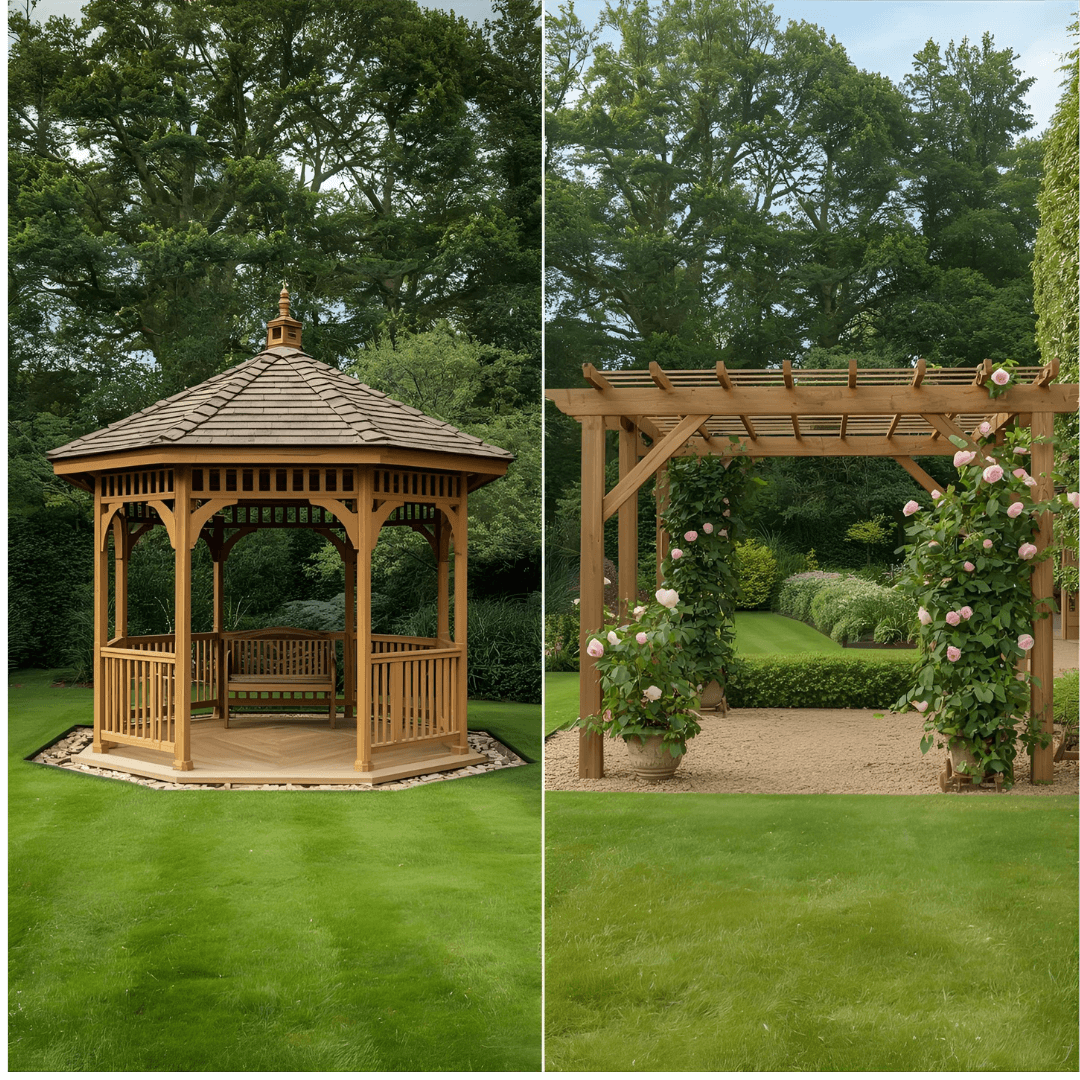
Gazebo vs Pergola? The Complete Comparison Guide
Can't decide between a gazebo and pergola? Here's the deal: gazebos have full roofs for complete shelter, while pergolas feature open lattice tops for partial shade. Keep reading to discover which structure suits your garden, budget, and British weather best!
Gazebo vs. Pergola: Key Differences
A gazebo stands alone in your garden with a proper roof. Most come in octagonal or hexagonal shapes with full coverage that keeps rain off your head.
Pergolas use elegant columns holding up a slatted or latticed roof. They filter light rather than block it entirely. You can attach them to your house or have them freestanding. Gazebos always stand independently.
Roofing and Weather Protection
Gazebos handle British weather brilliantly. That solid roof means you can sit through drizzle, rain, even blustery autumn days. Perfect for garden parties whatever the forecast.
Pergolas give you dappled shade on sunny days. But rain protection? Not their strong suit. You can add retractable canopies or climbing plants for more coverage, but you won't get the same shelter.
If you live somewhere with heavy rainfall or strong winds, a gazebo makes more sense.

Cost & Maintenance
Gazebos cost more upfront due to complex construction and proper roofing. Installation often needs foundation work and professional help. Roofing systems need regular checks, and wood requires periodic treatment.
Pergolas are budget-friendlier with simpler construction and easier installation—some manage it as a DIY weekend project. Maintenance is straightforward: occasional wood treatment, stability checks, and plant trimming. Metal or vinyl pergolas need even less hassle.
Get quotes from several suppliers—prices vary wildly.
Aesthetic and Functional Considerations
Gazebos make a statement. They're showstoppers that draw the eye and invite people over. Inside, you've got a cosy, enclosed space perfect for furniture, fairy lights, and cushions.
Pergolas add height and structure without dominating. Their real beauty emerges with climbing plants—wisteria in spring, roses in summer. You get a living structure that changes through seasons.
They're brilliant for creating garden "rooms"—defined spaces that feel separate without blocking views.

Use Cases
Gazebos excel for all-weather outdoor dining, hot tubs, garden offices, or meditation spaces. They're popular for garden events where guests need comfort regardless of weather.
Pergolas shine over patio seating for dappled shade, creating walkways between garden areas, or supporting climbing plants. Attached pergolas extend living space from house to garden without solid barriers.
When to Choose Each
Choose a gazebo if weather protection matters. If you want year-round outdoor space, not just occasional sunny weekends. They're the practical choice for unpredictable climates.
Choose a pergola if you love open, airy garden feelings. If you want something that blends seamlessly and you're excited about training climbing plants. They work best when you primarily use your garden during pleasant weather.
Which Suits My Space?
Gazebos need proper space—minimum 3-4 metres diameter. They work best as central features or in corners, but can overwhelm smaller gardens. You need level ground with clearance from boundaries and trees.
Pergolas adapt to space constraints better. Attached versions extend patios without eating lawn space. Their open structure prevents overwhelming compact gardens.
Think about sun patterns. Position pergolas to maximise shade during hot afternoons. Gazebos offer flexibility since they provide constant shelter anywhere.
Placement and Impact
Gazebos need clear pathways and visual connection to your house. Think of them as destinations—somewhere you journey to. They work beautifully at path ends or where they catch your eye from windows.
Attached pergolas blur inside-outside lines, making homes feel expansive. Freestanding pergolas divide larger gardens into zones or create inviting pathways. Their lighter impact means they integrate rather than dominate.
Related FAQs
What is the main difference between a gazebo and a pergola?
Gazebos have fully enclosed roofs keeping rain off completely. Pergolas have open, slatted roofs providing shade but not rain protection.
Which is better for UK weather?
Gazebos. British weather demands proper protection. Pergolas suit Mediterranean climates better than British drizzle.
Are gazebos more expensive than pergolas?
Yes. Complex construction and roofing systems push costs higher, plus installation typically requires more labour.
Which requires more maintenance?
Gazebos need more attention for roofing systems and weatherproofing. Pergolas just need periodic stability checks and treatment.
What materials are available?
Both come in wood, metal, or vinyl. Wood looks natural but needs treatment. Metal and vinyl last longer with minimal maintenance.

